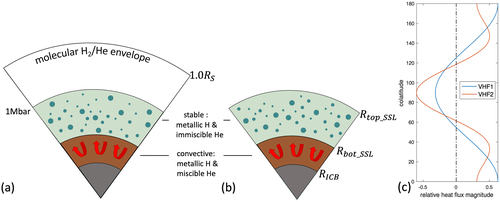AZoQuantum speaks with Sabine Stanley and Chi Yan from Johns Hopkins University. Simulations of the interior of Saturn, created by the researchers, have revealed a connection between the planet’s magnetic field and its thick shell of helium rain.
Can you give our readers more information about your recent research?
In our research, we use observations of Saturn’s magnetic field, made by the Cassini spacecraft, to try and determine the properties of Saturn’s deep interior. We use computer simulations of the dynamo process deep inside Saturn to see what ‘ingredients’ we need to create the unusual magnetic field seen at Saturn. We found that a thick helium rain layer surrounding the dynamo region is needed in our models, as well as a specific temperature pattern at the top of the helium rain layer in order to produce the structure seen in Saturn’s magnetic field.
Can you tell us more about the type of probe that was used to find out this information?
Saturn’s magnetic field was mapped by the magnetometers onboard the Cassini spacecraft. During the final stage of its mission (known as the Grand Finale orbits), Cassini dove between Saturn and its rings along polar orbits, and mapped Saturn’s magnetic field and its gravity field in greater detail than ever before.
What are some of the features that the data revealed about Saturn’s magnetic field?
The most striking feature of Saturn’s magnetic field is its perfect symmetry about the rotation axis. We call this an “axisymmetric” field. If you were to float at a certain latitude on Saturn’s surface, you would find the magnetic field to be exactly the same at all longitudes.

Image Credit: Shutterstock.com / Elena11
How does the magnetic field of Saturn differ from similar fields found elsewhere in our planetary system?
No other planet has such perfect axisymmetry in its magnetic field, except maybe Mercury. We need more data about Mercury’s magnetic field to confirm whether its field is also as axisymmetric as Saturn’s.
The team at Johns Hopkins University created computer simulations of the dynamo-like processes which create that magnetic field. How were these computer simulations created?
These computer simulations of the dynamo are somewhat similar to climate models or ocean circulation models. They solve for the fluid motions in the region based on the forces acting. So they solve similar nonlinear equations, except dynamo models need an additional equation that solves for the magnetic field.
What do the computer simulations suggest about Saturn?
The computer simulations suggest that specific features of Saturn’s magnetic field can be reproduced if Saturn contains a stably stratified layer (due to helium rain at these pressures) at the top of the dynamo region expanding from 40-70% of Saturn’s radius. It is also suggested that the temperature at the top of the stable layer should be warmer in the equatorial regions and colder at higher latitudes.

(a) Schematic of Saturn’s interior structure. From top to bottom, the molecular atmospheric layer is in white, the helium rain layer in light green, the convective and electrically conducting layer in dark brown and the inner core region (which is possibly stably stratified or solid) in gray. (b) The interior geometry used in the numerical dynamo models. The simulations do not model the molecular H2/He envelope and assume that the inner rocky/icy layer is solid. (c) The heat flux perturbation profiles at the top of the stably stratified helium rain‐out layer, as a function of colatitude. Units are non‐dimensional. Image Credit: https://agupubs.onlinelibrary.wiley.com/doi/10.1029/2020AV000318
By studying Saturn and how it has evolved, what can we learn about the formation of other planets in the solar system?
Studying Saturn also provides insights into the interior structure and evolution of the other gas giant planet in our solar system, Jupiter. Indeed, the existence of helium rain has also been proposed inside Jupiter, even though the thickness of the helium rain layer may be smaller than the one inside Saturn. Studying Saturn also provides us with knowledge of gas giant planets around other stars, i.e., exoplanets.
What information is required to measure the length of a day on Saturn?
Unlike other planets, we don’t have a straightforward way to measure the length of a day on Saturn. For rocky planets, like Mars or Mercury, we measure the length of a day by measuring how long it takes for a fixed surface feature, like a crater or a volcano, to reappear at the same location. However, Saturn doesn’t have a solid surface and the winds at the surface move at different speeds, so we can’t really use those to measure the length of day.
For giant planets, like Jupiter, Saturn, Uranus and Neptune, we try to use the magnetic field that is rooted deep in the planet. If there is an angle between a planet’s magnetic field axis and its rotational axis, then the length of a day can be determined by observing when radio emissions emitted from near the planet’s magnetic pole beam at us. This happens once per “day” on that planet. However, we cannot apply this method to Saturn because the magnetic axis and rotation axis are perfectly aligned. So instead, scientists use Saturn’s gravity field or oscillations of Saturn’s rings due to waves in Saturn’s deep interior to estimate its length of day.
What’s next for the team at Johns Hopkins University?
We are going to keep studying Saturn and see if we can learn even more about the planet’s interior by creating more sophisticated models of the planet’s magnetic field. We are also studying many other planets in the solar system, as well as exoplanets, trying to understand their magnetic fields.
Where can readers find more information?
Please see our recently published paper for more details: https://doi.org/10.1029/2020AV000318.
About Sabine Stanley
 Sabine Stanley is a Bloomberg Distinguished Professor at Johns Hopkins University in the Department of Earth & Planetary Sciences and the Space Exploration Sector of the Applied Physics Lab. She received her Ph.D. in Geophysics from Harvard University. Prior to joining Johns Hopkins she was a Postdoctoral Researcher at MIT and a Professor at the University of Toronto. Sabine’s awards and honors include the Dean’s Outstanding Teaching Award and the Ranjini Ghosh Excellence in Teaching Award from the University of Toronto, the William Gilbert Award of the American Geophysical Union, a Sloan Research Fellowship and a Canada Research Chair.
Sabine Stanley is a Bloomberg Distinguished Professor at Johns Hopkins University in the Department of Earth & Planetary Sciences and the Space Exploration Sector of the Applied Physics Lab. She received her Ph.D. in Geophysics from Harvard University. Prior to joining Johns Hopkins she was a Postdoctoral Researcher at MIT and a Professor at the University of Toronto. Sabine’s awards and honors include the Dean’s Outstanding Teaching Award and the Ranjini Ghosh Excellence in Teaching Award from the University of Toronto, the William Gilbert Award of the American Geophysical Union, a Sloan Research Fellowship and a Canada Research Chair.
About Chi Yan
 Chi Yan is a Ph.D. student who recently graduated from the Department of Earth & Planetary Sciences at Johns Hopkins University. She will continue her research on planetary dynamos as a postdoc in Professor Stanley’s group.
Chi Yan is a Ph.D. student who recently graduated from the Department of Earth & Planetary Sciences at Johns Hopkins University. She will continue her research on planetary dynamos as a postdoc in Professor Stanley’s group.
Disclaimer: The views expressed here are those of the interviewee and do not necessarily represent the views of AZoM.com Limited (T/A) AZoNetwork, the owner and operator of this website. This disclaimer forms part of the Terms and Conditions of use of this website.